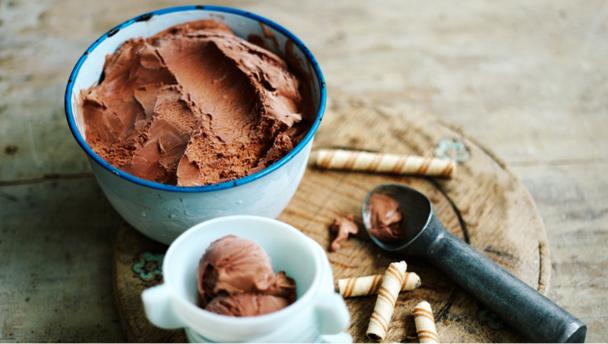

By Hugh Fearnley-Whittingstall
How could we live without chocolate? Fortunately, we don't have to, so dive into these recipes for chocolate brownies, cake, ice cream, hot chocolate, chocolate chip cookies, chocolate tartlets - the list goes on and on!
 Beef chilli with bitter chocolate
Beef chilli with bitter chocolate
 Bruno Loubet’s bean and vegetable chilli
Bruno Loubet’s bean and vegetable chilli
 Gooey chocolate mousse cake
Gooey chocolate mousse cake
 Chocolate Easter egg nest cakes
Chocolate Easter egg nest cakes
 White chocolate and ginger cheesecake
White chocolate and ginger cheesecake
 Mini three-way biscuits
Mini three-way biscuits
 Chocolate orange cupcakes
Chocolate orange cupcakes
 Easy chocolate cake
Easy chocolate cake
 Chocolate sponge cake
Chocolate sponge cake
 Homemade Irish cream
Homemade Irish cream
Chocolate is made by roasting and grinding up cocoa beans to yield chocolate 'liquor'. This comprises around 50 per cent cocoa solids and 50 per cent cocoa butter (the fat from the beans). In the labelling of chocolate the cocoa solids generally include the cocoa butter - it's basically all the bits of the chocolate that are from the cocoa pod rather than the later additives such as sugar, milk, lecithin, vanilla, etc.
A huge range of eating and cooking chocolate is available in supermarkets and specialist shops, including chocolate made from organically grown ingredients and coming from Fairtrade sources. The difference between all the various brands depends on the type of cocoa beans used, the proportion of cocoa solids and cocoa butter, the sugar content and the flavourings. Producers of chocolate must meet certain minimum requirements before they can use the names prescribed by law for chocolate and its different types, such as milk chocolate. When buying chocolate, read the list of ingredients. Look at the percentage of cocoa solids and sugar, as this indicates the quality and taste of the chocolate. The higher the cocoa content, the less sugar it contains and the more 'chocolatey' it's going to be.
Seek out quality chocolate - the results will shine through. High-quality chocolate will make a distinctive, crisp, snap when broken, shattering cleanly. It should also start to melt when you hold it in your hand for a few seconds - the quicker the better, as this indicates a high cocoa butter content. (Cocoa butter has a melting point of 37C/99F, just below human body temperature, which is one of the factors that gives chocolate its enduring appeal.) In less expensive chocolate, vegetable oils and shortening have been substituted for the cocoa butter, and may even have been through the process of hydrogenation to lower these fats' melting point and reproduce cocoa butter's essential characteristic.
Legally, all chocolate can contain up to 5% vegetable fat and this must be one or more of the six types of vegetable fat specified by the European regulations.
Store chocolate tightly wrapped in its original packaging or in cling film in a cool, dry place. Properly stored, plain chocolate will keep for a year; milk and white chocolate will keep for about six months (it will still taste okay after this time, but will not melt as well if kept any longer). If stored at warmer temperatures, chocolate can develop a 'bloom' - a white, filmy residue. This 'bloom' may well be 'cocoa butter bloom', which indicates that the chocolate wasn't tempered correctly, or that it has got too warm and then cooled down again, allowing some of the cocoa butter in the chocolate to separate from the cocoa solids, rise to the surface and re-crystallise. This doesn't always affect the flavour of the chocolate, but should be seen as a warning that it hasn't been stored in ideal conditions. Tempering the chocolate again to realign its crystalline structure can rectify the bloom.
There is a second type of 'bloom', referred to as a 'sugar bloom', which is caused by moisture settling on the surface of the chocolate: this can happen when the bar is stored in a damp atmosphere. Any moisture that comes into contact with chocolate draws up the sugar crystals to the surface; the sugar then dissolves in the water and later re-crystallises on the surface, destroying the texture of the chocolate. The whole appearance and texture of the chocolate will be grey and gritty, and sadly the only place for the bar is the bin. For this reason, take care when storing chocolate in the fridge; it's best kept in an airtight container.
Chocolate is used in a wide spectrum of dishes. Cocoa powder provides a concentrated chocolate flavour in cakes, biscuits and icing. Block chocolate is used in richer cakes, chocolate mousses, tarts, cheesecakes, sauces and ice cream. The epitome of chocolate for most chocolate lovers is the indulgent chocolate cake. There are hundreds of chocolate cake recipes and variations, including the classic Black Forest gâteau, the Austrian truffle cake Sachertorte, chocolate fudge cake and chocolate brownies.
A high-quality chocolate with 70 per cent (or more) cocoa solids, with its deep cherry tones, almost liqueur-like tangs and bitter sweetness, can be used with meat dishes to complement rich meats in much the same way as red wine does. Several Spanish Catalan dishes are flavoured with chocolate; Mexico has its mole (a chilli and chocolate sauce that's the basis of several meat dishes); in Italy chocolate is paired with boar and hare - it goes particularly well with game.
Type the ingredients you want to use, then click Go. For better results you can use quotation marks around phrases (e.g. "chicken breast"). Alternatively you can search by chef, programme, cuisine, diet, or dish (e.g. Lasagne).